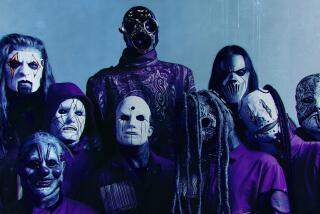Sly
- Share via
Sly Stone, the Howard Hughes of the Woodstock scene, rolled up on a hulking three-wheel custom chopper painted the color of lemons. His straggly hair was tucked up beneath an ebony San Francisco Giants baseball cap with sparkly silver threading and draped on his shoulders was the type of shirt you don’t expect to see unless you happen to be Flavor Flav’s dry cleaner -- it was emblazoned with images of gambler’s dice and the $100 face of Ben Franklin.
“I’m sorry I’m late,” he said with a somber expression as he walked into the empty, off-hours Temple Bar in Santa Monica and pulled off his gray wool gloves. Late? Stone was technically tardy by all of 13 minutes, but the apology had the ring of a larger truth.
Sly and the Family Stone became famous for making some of the most euphoric, genre-busting music of the late 1960s and early 1970s -- songs such as “Family Affair,” “Stand,” “Dance to the Music” and “I Want to Take You Higher” -- but the group’s leader was also notorious as the slipperiest of stars: There were missed concerts, ugly drug escapades, arrests, promoter feuds and nasty infighting in the band. The music of the Family Stone was transcendent in the 1960s, but, by the middle of the following decade, the dream was over and Stone was on his own and living on vapors.
There were comeback attempts and albums with somewhat pleading titles (“Heard Ya Missed Me, Well I’m Back” in 1976 and three years later “Back on the Right Track”), but the arc of his story was turning grim, and he became more and more reclusive.
Now, he says, he wants to rejoin the world of everyday people.
“I am ready to show people what I can do,” Stone said, sipping a double margarita and smiling that familiar toothy grin, although the 1960s towering afro is long gone along with his funky saunter. His posture and movement show the damage of the years when he was living especially hard. Stone’s chin never leaves his collarbone when he talks and there’s a tremor and hitch to his collarbones. The hunched 65-year-old R&B; icon apologized to the photographer who had come to shoot his portrait.
“I’m like this because I fell off a cliff,” he said, referring to a spill he said he took “walking in my yard” in Beverly Hills.
There’s a sense that Stone went over the edge plenty of times in the years when he was a J.D. Salinger of funk.
It’s hard to pin down the facts with Stone, and it wasn’t made easier by the fact that he did a chunk of this interview with his hands on a keyboard and speaking into a vocoder synthesizer that turned his words into trippy music -- it was like carrying on a conversation with Disneyland’s Main Street Electrical Parade. “Can you understand me? Can . . . you . . . understand me? That’s goooooood.”
Stone, who rarely does interviews, did this one for a reason that’s of considerable importance to him. He wants to mount a world tour and he’s back with some of the original Family Stone members: trumpet player Cynthia Robinson, saxophonist Jerry Martini and Sister Rose Stone. Right now he’s got just four dates booked, the first of them Friday at the House of Blues on the Sunset Strip, followed the next night at the chain’s Anaheim site.
More than that, he wants to prove himself to the music industry, get in the studio with many of the stars he’s influenced and hook a young audience.
Stone always has been one quirky cat, but he seemed neither scattered nor feeble this day. He said the only real regret is letting down fans in the past. “I got in fights with promoters, and I had a real attitude then -- well, I kind of still do but not the same -- so I walked away. But I forgot the people in the audience, the people who loved the music. The music meant a lot to people, and it comes with a responsibility.”
Stone’s longtime manager, Jerry Goldstein, is still with him, but this year the singer brought in Charles Richardson, an old friend, to be his personal manager, and that led directly to the new club shows, which include May dates in Minneapolis and Chicago. Stone has also been increasingly active in the studio, including sessions with funk giant George Clinton and has, according to Richardson, “20 years’ worth of amazing material that he can work on.” The singer himself says much of that work has been influenced by the hip-hop era.
Richardson said that promoters have made it clear that Stone is a commodity if he can prove with the club shows that he and his band can bottle up the old magic. Sales to the shows have been sluggish. “If Sly shows he can go the distance, we’re told that the world is his oyster,” Richardson said. The Rock and Roll Hall of Fame member has also reached out to two other original Family Stone members -- his brother, Freddie, and drummer Greg Errico -- and they may join the revival effort after the club dates, Richardson said.
Musical origins
SYLVESTER STEWART was born in Denton, Texas, where the official town motto is “north of ordinary,” but he grew up in Vallejo in the Bay Area, which in the 1960s could have been called “east of weird.” His music career was a family affair right from the get-go. He was the second of five children, and he and Freddie, Rose and Vaetta were a gospel group called the Stewart Four and even cut a single in 1952.
“When I was 4, I had a job singing with Sam Cooke on a church show in Oakland Auditorium,” Stone said, his fingers trailing across the keyboard as he talked. “I remember people ran down the aisles, and I didn’t know about the consequences or applause or celebration. I didn’t know what music did to people. So I started running. It scared me. That was the first chance I got to see the response you could get from an audience by performing. Since then, I got that same feeling in a way, sometimes. You know: Run.”
In the ‘60s, Stone studied trumpet, composition and music theory at a junior college and immersed himself in the roiling music scene of the Bay Area as a disc jockey at soul station KSOL in Oakland and as a producer in San Francisco (he worked with Grace Slick’s first band, the Great Society, as well as with Bobby Freeman and the Beau Brummels).
All of this began to shape a music sensibility that was part soul and part psychedelic, a hybrid that would channel both the Apollo Theater and Haight-Ashbury and, eventually, create an essential template for 1970s funk.
It’s impossible to imagine Prince or Rick James without Stone’s influence, and his music would echo clearly in the records of Earth, Wind & Fire, Parliament/Funkadelic, the Ohio Players, Shuggie Otis and Terence Trent D’Arby, to name just a few.
More than the music, the image of the Family Stone on stage was powerful. The ensemble was a mix of gender and race, an ideal collective for an audience eager to live the Age of Aquarius and hear message music that, as a bonus, had a great beat.
The golden moment for the band was its August night at the Woodstock Festival in 1969. Sly performed a delirious call-and-response version of “Higher” and listened to the crowd of 400,000 sing his words back to him. Many say that set changed the course of music, melding rock with R&B; in a liberating way.
“Everybody I saw was full of peace, it was a spirit there that was just peaceful and cool,” Stone said. “The thing I really remember is I went to whatever was the main street there and I got a bologna sandwich. And it was so hot. And I never open a sandwich to look what’s going on, but somehow I thought that time that I would do that. Because it was hot and I didn’t think bologna sandwiches were hot. And I opened it and there were people running across the meat. And, I thought, whoa.”
When someone says that they found tiny humans on top of their lunch meat, the next natural question is: You didn’t eat the sandwich, did you? “No! Oh, no, no. I was reluctant to even throw it away. I had to look around for, you know, to find the right garbage can that I should put it in.”
The downhill run
Times got darker after Woodstock. Stone moved to L.A. in 1970 and fell in with a thuggish crowd that whispered and snarled in his ear. Joel Selvin, author of the 1998 book “Sly and the Family Stone: An Oral History,” said the move away from the Bay Area was the “worst thing that could have happened to Sly, it was the beginning of the end.”
The 1971 album “There’s a Riot Goin’ On” showed the influence of Black Panther militancy on Stone, and the imagery of some lyrics showed how fast the rainbow ideal had changed. The late 1970s and 1980s found Stone tumbling through a career trapdoor and cushioning the fall with drugs. Stone usually made headlines only of the negative kind, for arrests, episodes involving guns and drugs and squabbles over child support payments.
Like that wide-eyed youngster back at the Oakland church show, Stone decided to just run. As the years went on, he said, he had some people in his close circle who advised him to be the hermit and bide his time for the big comeback. Eventually, though, he realized that that comeback had to be in his head, not on stage.
“If there is anyone I have influenced who wants me to help them record, I’m willing to do it. I want to go in the studio yesterday and get started. The reason I say that I want to hear from people is that I was influenced to stay underground for so long. I had advice that there was some kind of rewarding effect to it. Now I want to be over ground. I want to be above ground. I don’t want to be in the ground.
“I want phone calls to come. Call me. I want to work with Clive Davis again. My favorite person on Earth. I need to prove myself, I know that. He needs to hear something. I don’t need to send a demo. He’ll understand when he hears something I say or do. Then he’ll call, and then it’s on.”
A few of the employees at the Temple Bar were getting ready to open the place a few hours later and stopped what they were doing as Stone started singing some new lyrics, one of many he says he has; this one had a hip-hop cadence. “I’m the real model and not the role model. . . .”
The notion of a Stone comeback is intriguing. There’s a precedent: Brian Wilson has certainly shown that a revered 1960s pop auteur who blew some fuses can overcome the electrical damage and reconnect with a loving and forgiving audience. It’s not clear if Stone can pull it off.
Selvin, for one, is dubious after hearing of some other small shows Sly recently gave. “It’s amazing the guy is still alive, but he seems unlikely to be able to fully regain his footing,” said the author and pop critic at the San Francisco Chronicle. “He’s a long way from the incredible and unpredictable Sly Stone of 40 years ago.”
“If he can get it together and take the music out on the road, if he can capture what he had before, there’s one or two generations that haven’t seen him or that band play those songs,” said Ken Ehrlich, the executive producer of the Grammys. “That music -- no one had heard anything like it quite before. I know I want to see him play if he can do it again.”
Ehrlich gave Stone a chance a few years ago with mixed results. Stone made his first major public performance in two decades in February 2006 at the Grammys at Staples Center. Contemporary stars performed chunks of Family Stone hits in a medley and then Sly, grinning and looking a bit shaky, emerged for a few seconds, jabbed the keyboard, and sang a few rough lines. He was in a shiny silver coat and had a huge blond mohawk. Other artists, like Steven Tyler of Aerosmith and Adam Levine of Maroon 5, were giddy to see the mystery man up close and offered polite praise for his less-than-riveting effort.
Stone himself was not pleased with the night. “It wasn’t what I thought it would be, and it’s not what I wanted it to be, but that’s OK,” he said. The upcoming gigs and the reconstituted Family Stone will look back on that Grammys night as a preamble to the real comeback.
“There’s things that can’t go wrong because there’s so many other people involved and on stage they are just galloping. If I wanted to, I could just take a minute to think, and it’s fine. It keeps going.”
Stone posed for a few more photos, including some with daughter Novena Carmel, who is following in his musical footsteps and is eager to share the family stage at the House of Blues shows and beyond. She said it’s hard sometimes reconciling what she knows about her father with his public persona. But she doesn’t try to portray him as an ordinary guy. “No, no, he is unique. Every day is like a new genre with him. It’s just like his music: You don’t know where it’s going, but you want to watch to see what’s next.”
Ready to leave, Stone was giving the photographer some playful grief about too many shots, too many poses, too much time already taken. The singer pulled off his sunglasses, and one of his eyes was deep red where it should be white, maybe the remnant of some fall off a cliff at some point. “Can I say goodbye now?” He started to leave, but he was coaxed back. He pivoted, stood in the light and summoned up one more big smile.
--
More to Read
The biggest entertainment stories
Get our big stories about Hollywood, film, television, music, arts, culture and more right in your inbox as soon as they publish.
You may occasionally receive promotional content from the Los Angeles Times.










